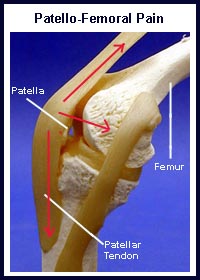In order to better understand patellofemoral pain, it is important to understand the anatomy and function of the knee and the knee cap (patella). Please review the section on knee anatomy before reviewing this section. You should also review the more specific section on the basic anatomy of the patellofemoral joint. Other terms used to describe this pain include “knee cap pain” and “anterior knee pain” (anterior means front).

What is patellofemoral pain?
Patellofemoral pain can occur in one or both knees and it is one of the most common causes of knee pain. Patellofemoral pain is felt in the front of the knee and occurs when the patella is compressed against the femoral groove. The compression forces increase the further the knee is bent and as a result pain usually increases as well. Therefore, patellofemoral pain may be made worse by activities that involve repetitive bending of the knee. Pain is often felt going up or down stairs or after sitting for long periods of time. Patellofemoral pain can be accompanied by “clicking” or “grinding” and sometimes by a feeling that the knee “catches” or wants to “give way”.
What causes patellofemoral pain?
Patellofemoral pain describes the location of the pain but not its cause. Overuse (“too much, too soon”) or previous injury to the knee are common causes of patellofemoral pain. Biomechanical factors such as poor tracking of the patella in the femoral groove, flat (pronated) feet, weak inner thigh muscles and tight outer thigh muscles and/or ligaments can also cause patellofemoral pain. Sometimes “wear and tear arthritis” (osteoarthritis) or damage to the articular cartilage (chondromalacia) on the back of the patella causes the pain but in most cases of patellofemoral pain the knee joint is normal.
How do you test for patellofemoral pain?
Examination techniques that detect biomechanical problems are helpful in the diagnosis of patellofemoral pain. Xrays are often done to assess the shape of the patella and to rule out osteoarthritis of the knee. Rarely are other tests such as Magnetic Resonance Imaging (MRI) required.
What is the treatment for patellofemoral pain?
The treatment of patellofemoral pain depends on its cause and may include stretching and strengthening exercises, relative rest, icing, medication, foot orthotics and bracing. In rare cases, surgery is required. Doctors and physiotherapists trained in treating patellofemoral pain can outline a treatment plan specific to each individual.
To read more about how orthotics can help patellofemoral pain click here. To read more about patellofemoral braces click here. Please visit the links section for additional information on patellofemoral pain. Links have been provided to other websites as well as online medical journals. Other knee injury topics can also be accessed.
